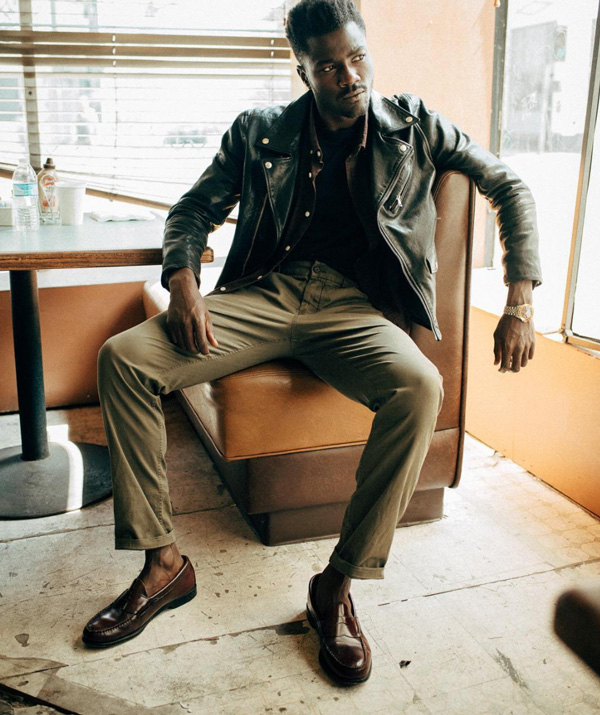The Significance of Sustainable Garments: Exactly How It Influences the Atmosphere and Your Storage room
Lasting garments is progressively identified for its critical function in lessening the ecological influence of the rapid style market. By concentrating on environment-friendly materials and moral manufacturing techniques, it deals with pushing environmental issues. This change not only profits the planet however additionally affects consumer selections, resulting in a much more thoughtful strategy to wardrobe management. Recognizing these characteristics elevates crucial concerns regarding style's future and personal duty fit it.
The Ecological Footprint of Rapid Style

Benefits of Lasting Products
Lasting products supply substantial advantages, specifically with green textile choices that decrease ecological harm. These products also demonstrate sturdiness and longevity, reducing the requirement for constant replacements. As a result, they add to an extra sustainable fashion business and advertise accountable customer actions.
Eco-Friendly Textile Options
While the fashion business has long been associated with rapid fads and ecological injury, the increase of environmentally friendly fabric selections presents a transformative opportunity. Sustainable products such as natural cotton, hemp, and Tencel have actually gained appeal because of their lower ecological influence. These materials are typically generated without dangerous pesticides and need less water, lowering their carbon footprint - Branded Clothing. In addition, numerous environmentally friendly textiles are biodegradable, adding to a round economy by lessening waste. Choosing sustainable products not just supports ecologically responsible methods yet also promotes much healthier environments. As customers come to be more knowledgeable about their purchasing power, the demand for environment-friendly textiles urges brand names to innovate and take on even more lasting manufacturing approaches, inevitably profiting the earth and future generations
Toughness and Longevity Benefits
Lots of customers are significantly identifying the durability and longevity benefits of lasting products in their clothing choices. Unlike standard fabrics, lasting materials such as organic cotton, hemp, and recycled polyester are crafted to withstand wear and tear, causing garments that last much longer. This minimized frequency of substitute not just conserves consumers cash gradually but likewise lessens waste generated by rapid style. Furthermore, sustainable clothing typically employs eco-friendly manufacturing approaches that boost material stamina, adding to a decrease in the general carbon footprint. By buying sturdy apparel, customers can cultivate an extra lasting wardrobe while taking pleasure in high-quality items that keep their aesthetic and performance with time. Subsequently, toughness and longevity stand as key benefits of choosing sustainable products.
Decreasing Waste Through Lasting Practices
Minimizing waste in the garment industry can be accomplished with cutting-edge practices such as upcycling and repurposing products. Additionally, taking on minimal wardrobe methods urges customers to focus on quality over quantity, ultimately decreasing clothing intake. Together, these methods contribute considerably to a more sustainable clothes model.
Upcycling and Repurposing Products
Upcycling and repurposing products have actually become innovative methods in the style market, changing discarded fabrics into beneficial brand-new items. This approach not only decreases waste yet likewise urges creative thinking and originality in apparel design. By taking old garments and products, designers can create special items that mirror individual design while decreasing the need for brand-new sources. In addition, upcycling typically needs much less power and water compared to typical production processes, significantly reducing the ecological impact of fashion. As consumers become much more aware of sustainability, the popularity of upcycled apparel remains to rise, promoting a circular economic climate. Inevitably, these methods contribute to an extra sustainable future, where fashion focuses on ecological wellness over rapid production and intake.

Minimalist Closet Approaches
As individuals significantly seek to lessen their ecological effect, embracing minimal closet strategies has obtained traction as an effective strategy to sustainable style. These methods emphasize quality click for info over quantity, encouraging customers to curate a smaller collection of flexible, sturdy garments. By concentrating on ageless items that can be mixed and matched, people can reduce the frequency of purchases and ultimately lower waste.Additionally, minimalism advertises mindful intake, urging shoppers to assess the ecological and moral effects of their selections. This approach not just fosters a much more sustainable lifestyle yet likewise streamlines daily decision-making regarding clothes. As people welcome minimal concepts, they add to a style culture that next page values sustainability and liable consumerism, ultimately leading to an extra eco-conscious society.
The Role of Moral Labor in Sustainable Fashion
While numerous customers are progressively familiar with the ecological consequences of their garments options, the importance of moral labor practices in lasting style can not be neglected. Honest labor includes reasonable wages, safe working conditions, and regard for workers' legal rights, forming the foundation of responsible fashion production. Brand names that focus on moral labor not just uplift areas yet also established a standard for liability in the industry.Moreover, the combination of moral techniques fosters openness, allowing customers to make informed options about their purchases. This practice contrasts greatly with quick fashion's exploitative labor designs, which usually prioritize revenue over individuals. By sustaining companies committed to ethical labor, consumers add to a system that values human dignity together with environmental sustainability. Ethical labor is not merely an add-on; it is important to the wider mission of lasting style, making certain that the mission for eco-friendliness does not come at the expense of human legal rights.
The Impact of Sustainable Clothes on Carbon Emissions
Sustainable garments has the prospective to significantly lower carbon emissions connected with the garment industry. Traditional garment manufacturing adds especially to greenhouse gas emissions, mostly due to energy-intensive production processes and the use of non-renewable resources. On the other hand, lasting fashion concentrates on environment-friendly products, such as organic cotton or recycled fibers, which typically call for much less energy to produce.Moreover, sustainable brands tend to take on much more efficient production methods, reducing waste and lowering general emissions. By prioritizing durability and classic style, sustainable apparel urges customers to buy less often, further reducing the carbon impact connected with overconsumption.Additionally, several lasting brands are committed to openness in their supply chains, enabling consumers to make educated options that line up with their worths. Inevitably, shifting in the direction of lasting clothes can bring about a substantial decrease in carbon emissions, contributing to a much healthier earth and a more sustainable future for the garment industry.
Sustaining Neighborhood Economic Climates With Lasting Selections
The shift toward sustainable garments not just addresses ecological problems but likewise significantly advantages regional economic situations. By picking sustainable fashion, consumers usually support local artisans and small companies, boosting community resilience. These enterprises generally operate a smaller sized scale, prioritizing craftsmanship and ethical practices over mass production.Investing in locally made sustainable apparel cultivates work development and promotes economic development within areas. As customers end up being extra knowledgeable about the ecological effect of their purchases, they increasingly look for out items that show their values. This need motivates neighborhood suppliers to embrace sustainable techniques, adding to a circular economy.Moreover, supporting neighborhood businesses decreases transportation emissions, aligning with eco-conscious customer actions. The interconnectedness of sustainable clothes and local economies underscores the essential role that specific options play in promoting both environmental and financial wellness. By promoting these local links, communities can grow while likewise working towards a much more sustainable future.
Changing Your Closet: Tips for a Lasting Wardrobe
As people look for to minimize their great site environmental effect, transforming a storage room into a lasting wardrobe comes to be a crucial step. One reliable strategy is to review existing clothes, maintaining just items that are used on a regular basis which line up with sustainability goals. Prioritizing high quality over quantity is important; buying resilient items from environmentally friendly brands can considerably minimize waste.Additionally, including second-hand products can revive a wardrobe while decreasing ecological damages. Organizing apparel swaps with close friends or contributing unused products can even more advertise sustainability.When shopping, individuals need to seek materials that are organic, recycled, or biodegradable, and prevent quick style retailers - Branded Clothing. Exercising conscious usage by attentively taking into consideration each acquisition can add to a much more lasting way of life. By implementing these ideas, one can develop a wardrobe that shows personal design while sustaining ecological stewardship
Frequently Asked Concerns
How Can I Identify Lasting Clothing Brands?
To identify sustainable clothes brands, one should investigate materials used, look for certifications like Fair Trade, and examine the brand name's openness regarding their production procedures, labor methods, and environmental impact, ensuring environmentally friendly and ethical techniques are focused on.
What Are the Expenses Connected With Sustainable Fashion?
The prices linked with sustainable style can vary considerably. Higher manufacturing expenditures, honest sourcing, and environmentally friendly materials commonly cause boosted list prices, which may discourage some customers while interesting ecologically conscious customers.
Can Lasting Clothes Be Stylish and Fashionable?
Lasting clothes can certainly be trendy and fashionable. Designers increasingly focus on innovative products and moral production approaches, showing that style and sustainability can coexist. Consumers currently have diverse choices that mix aesthetics with environmental awareness.
Exactly How Does Laundering Clothing Affect Their Sustainability?
Cleaning clothing considerably effects sustainability by consuming water and power, contributing to air pollution, and triggering microplastic launch. Frequent washing can degrade textiles, reducing their life-span and increasing the requirement for substitutes, ultimately intensifying ecological issues.
What Is the Life Expectancy of Sustainable Garments Contrasted to Fast Fashion?
The life expectancy of lasting apparel normally goes beyond that of rapid style products, usually lasting several years because of high quality materials and craftsmanship. In contrast, quick fashion garments may degrade rapidly, demanding even more frequent replacements. Lasting apparel is increasingly recognized for its crucial role in reducing the environmental effect of the rapid style market. While numerous consumers are increasingly aware of the ecological effects of their apparel choices, the relevance of honest labor practices in lasting fashion can not be forgotten. Branded Clothing. Sustainable clothes has the possible to greatly minimize carbon discharges linked with the fashion sector. In comparison, lasting fashion concentrates on eco-friendly materials, such as organic cotton or recycled fibers, which often require less energy to produce.Moreover, lasting brands tend to adopt much more effective production methods, reducing waste and decreasing general emissions. By focusing on toughness and timeless layout, sustainable apparel urges consumers to buy much less frequently, additional reducing the carbon footprint linked with overconsumption.Additionally, lots of sustainable brands are devoted to transparency in their supply chains, enabling customers to make informed selections that align with their values
Comments on “How Branded Clothing Combines Fit, Function, and Fabric Innovation”